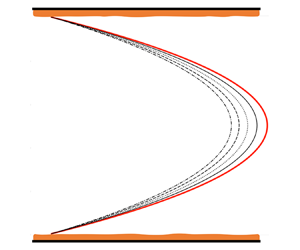No CrossRef data available.
Published online by Cambridge University Press: 25 November 2024

Microscopic irregularity (roughness) of bounding surfaces affects macroscopic dynamics of fluid flows. Its effect on bulk flow is usually quantified empirically by means of a roughness coefficient. A new approach, which treats rough surfaces (e.g. parallel plates) as random fields whose statistical properties can be inferred from measurements, is presented. The mapping of a random flow domain onto its deterministic counterpart, and the subsequent stochastic averaging of the transformed Stokes equations, yield expressions for the effective viscosity and roughness coefficient in terms of the statistical characteristics of the irregular geometry of the boundaries. The analytical nature of the solutions allows one to handle surface roughness characterized by short correlation lengths, a challenging feature for numerical stochastic simulations.